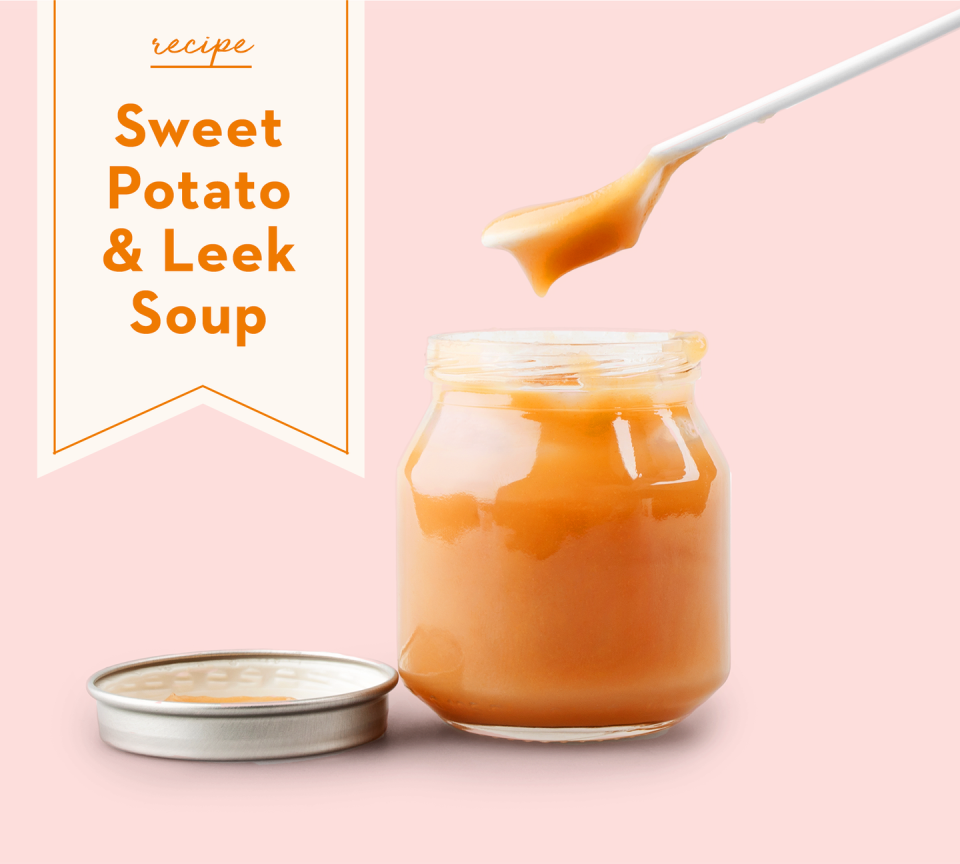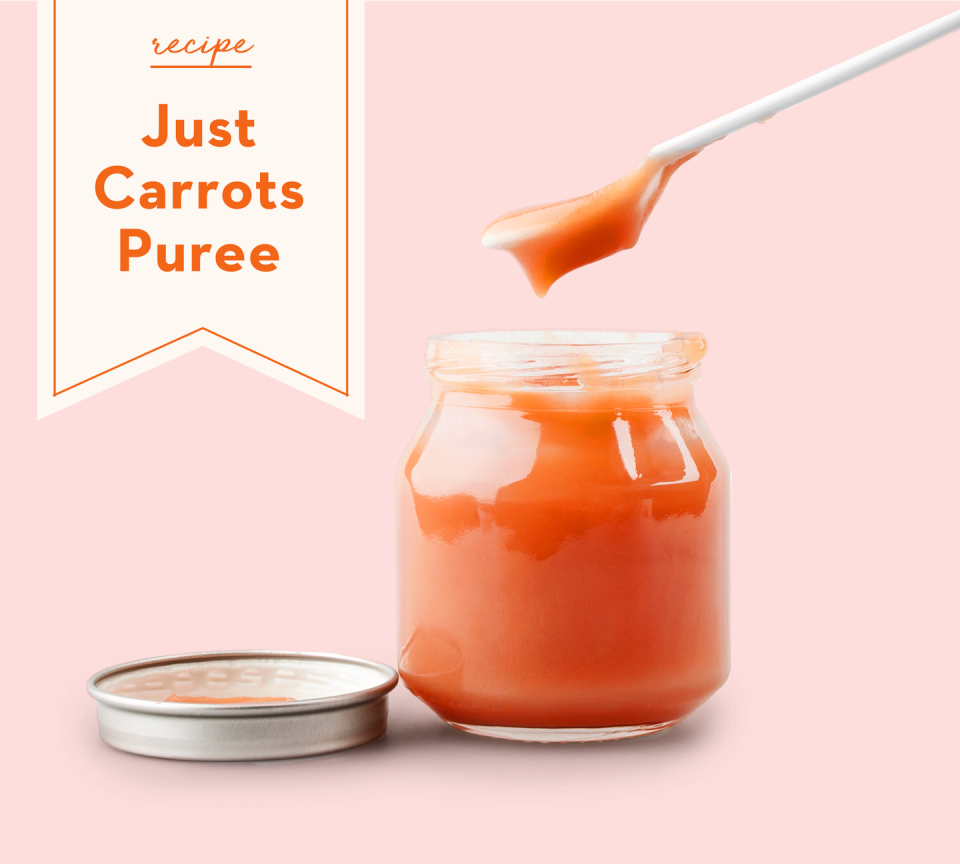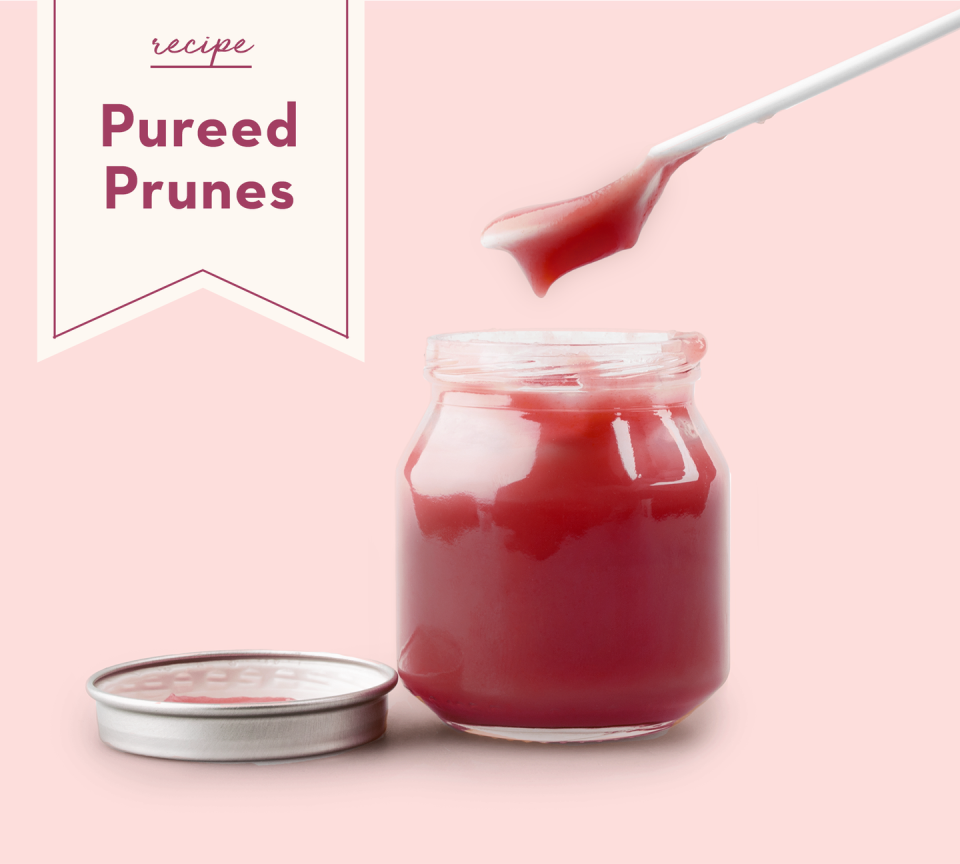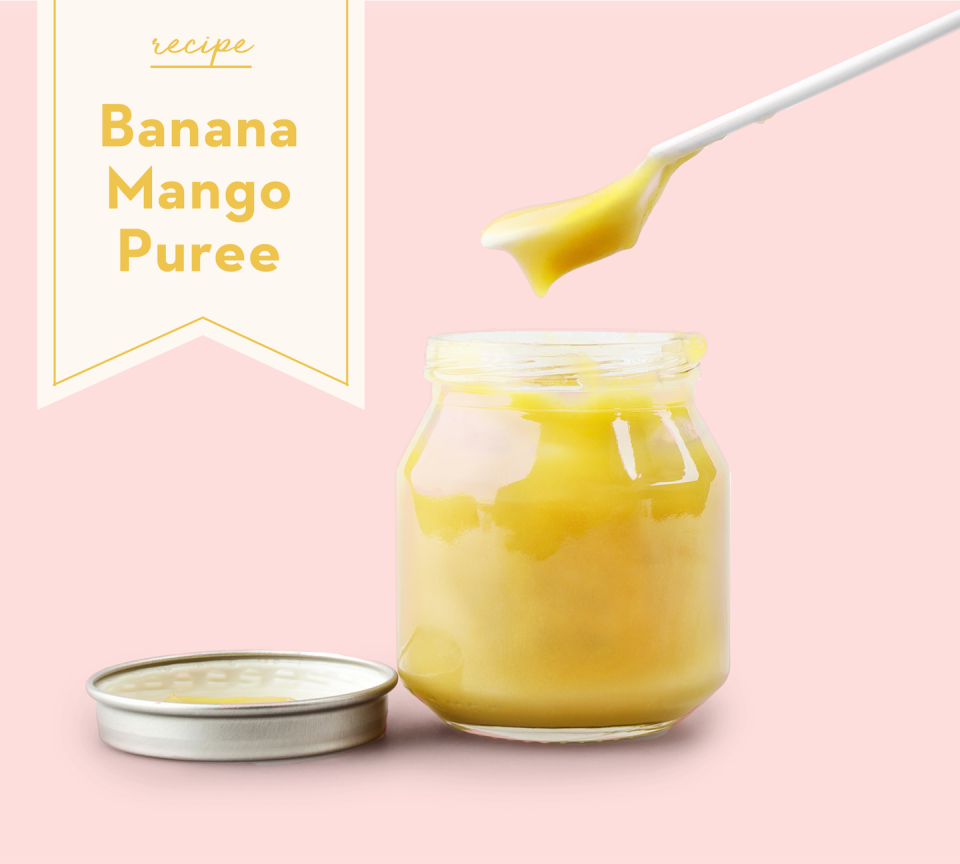The Ultimate Guide to Making Your Own Baby Food

You don't have to be a master chef to start making your own baby food at home. Although pre-packaged options are convenient and typically have a long shelf-life, homemade baby food has a slew of advantages which start with knowing exactly what you are feeding your baby.
By using your own ingredients and controlling the cooking process, homemade baby food is free from preservatives, less processed than the packaged varieties, and full of fresh nutritious ingredients. "Traditional baby food is heat pasteurized which kills many of the nutrients and results in a bland taste. The flavor component of homemade baby food is much superior to store-bought and cost savings is a big benefit as well," says Stephanie Middleberg, M.S., R.D., Founder of Middleberg Nutrition and best selling author of The Big Book of Organic Baby Food.
If you have the time and are ready to make the commitment, here is everything you need to know about making baby food at home, including recipes, tips, and resources.
Getting Started
First things first: Is your baby ready for solid food? Baby food stages provide general guidelines and are not standardized since every baby develops differently. It's best to consult with your pediatrician to help guide you through the process.
In general, Stage 1 foods consist of single ingredient purees and are ideal for babies ages 4-6 months. Stage 2 foods are for babies ages 6-9 months and start to incorporate more than one ingredient. Stage 3 foods are for babies 9-12 months, and they feature a lot of different textures and new flavors. Middleberg advises, "I look for signs like if your baby can sit up, if they have good neck control, and most importantly if they are showing an interest in food."
As your baby is getting started and just being introduced to food, it's important to remember that feeding is more-so for practice and getting your baby acquainted with food. "Keep in mind, when introducing new foods, you will only start with a small amount, like a tablespoon at a time so one jar of food could actually last for several feedings," says Molly Morgan, RD, CDN, CSSD, author and owner of Creative Nutrition Solutions.
Some essential tools and appliances you'll want to have on hand before making your own baby food include:
Blender, food processor, or strong immersion blender like Magic Bullet Baby Bullet, BEABA Babycook 4 in 1 Steam Cooker and Blender, or Homia Baby Food Maker
Steamer basket
Baking sheet
Saucepans
Spatula
Knife
Peeler
Ice cube tray
Baby food storage containers and jars like Oxo Tot Glass Containers and WeeSprout Baby Food Storage Jars
Freezer bags like Stasher Bags
Marker and labels like Chubbiee Baby Food Labels
Infant spoons and bowls like Avanchy Bamboo Set and Num Num Pre-Spoon
Mats and bibs like EZPZ Silicone Mat and Silicone Baby Bibs
Water, formula, or breastmilk, to thin out consistency
Homemade baby food recipe books like The Big Book of Organic Baby Food by Stephanie Middleberg
American Academy of Pediatric Resources including the Healthy Growth App from the American Academy of Pediatrics and American Academy of Pediatrics Infant Food & Feeding Guidelines
Homemade Baby Food Steps
Step 1: Clean and Sanitize
Clean your work surface and wash your hands thoroughly. Make sure all utensils, cutting boards, appliances, and countertops are cleaned. Wash and scrub your fresh produce (skip this step for frozen produce).
Step 2: Prep and Cook
Once your produce is washed, peel, and roughly chop the items if needed. Main cooking techniques include steaming, roasting, baking, or microwaving until tender (note that steaming and microwaving preserve the most nutrients).
Let the food cool slightly once cooked and then transfer to a food processor or blender. Morgan adds that soft fruits like bananas, avocado, or ripe mango do not need to be cooked first. If you're cooking the same food for the rest of the family, remember that baby's taste buds can be sensitive so it's best to remove the baby's portion before adding salt and seasonings to the rest of the meal for your family.
Step 3: Blend
Puree the food in a food processor with a little liquid, which can include water, formula, or even breastmilk. You can start with 1 tablespoon of liquid at a time, working your way up until it reaches a smooth consistency. Middleberg says that the texture of the baby food should glide off the spoon when you turn it over in the beginning, but you can start to bring it to a yogurt-like consistency relatively quickly.
As your baby gets older, you can also add in fully cooked eggs, beans, and meats (be sure to remove any fat, skin, and connective tissue). These items must be fully cooked since babies are at increased risk of foodborne illness. Middleberg also suggests adding a small amount of fat like ghee, coconut oil, or olive oil to provide essential fatty acids that are important for your baby and also develop the flavor profile of the food.
Step 4: Homemade Baby Food Storage
You'll want to store your baby food in airtight contains, freezer safe baggies, or even an ice cube tray. A marker and labels can help you keep track of what's on hand, as well as when the baby food was made. Middleberg says that frozen homemade baby food typically maintains best quality for 3-6 months. For fresh baby food, she recommends keeping it in the refrigerator for no more than 3 days.
Step 5: Reheating and Defrosting
For defrosting, Middleberg advises putting the baby food in the fridge the night before to thaw overnight, or simply taking it straight from frozen and rewarming it in a saucepan, then allowing it to cool before feeding to your baby. Morgan also adds to be sure to seal and refrigerate jars or pouches of baby food after opening between feedings.
Introducing allergen foods: The top eight food allergens include milk, eggs, fish, crustacean shellfish, tree nuts, peanuts, wheat, and soybeans. Middleberg says that if you are testing one of the top eight allergen foods, make sure to do so in the morning when your pediatrician office is open just in case of an emergency. If there are serious allergens in your family, be sure to consult with your child's physician or an allergist. Remember to never add honey to baby food or beverages for babies under 12 months, as it may contain Clostridium botulinum spores.
Homemade Baby Food Recipe Ideas

Not only do apples provide a sweet flavor, but they are easy to digest and are filled with nutrients. If you're comfortable adding the ginger, a small amount can help if your baby is gassy.
Stage: 3
Ingredients:
2 apples, peeled, cored, and cut into 1/4-inch dice
1/4 teaspoon grated fresh ginger or 1/4 teaspoon ground ginger
1 cup cooked lentils, drained if canned
1 cup cooked quinoa
Directions:
In a small saucepan with a steamer insert, bring about 1 inch of water to a boil. Add the apples. Cover and steam until tender, 5-10 minutes
Transfer the apples to a food processor or blender. Add the ginger. Puree until smooth, adding breastmilk, formula or water to achieve the desired consistency.
Gently warm the lentils and quinoa in a medium saucepan over low heat. Add the apple puree and mix well with a spoon. Store any unoffered puree in the refrigerator for up to 3 days or in the freezer for up to 6 months.
If you'd like a slightly less chunky puree, blend the lentils along with the apples, but leave the quinoa whole.
* Recipe provided by Middleberg

A meal that is ideal for one year olds, this recipe is filled with flavor and fiber.
Stage: 4
Ingredients:
2 tablespoons olive oil
1 onion, chopped
3 leeks, chopped
3 garlic cloves, minced
6 cups vegetable broth
4 sweet potatoes, peeled and chopped
1 teaspoon ground ginger
Pinch ground nutmeg
1/2 teaspoon sea salt
1/4 teaspoon black pepper
1 cup canned coconut milk
Directions:
In a large pot, heat the olive oil over medium-high heat until it shimmers. Add the onion and leeks and cook, stirring occasionally, until soft, about 7 minutes. Add the garlic and cook, stirring constantly, until fragrant, about 30 seconds.
Add the vegetable broth, sweet potatoes, ginger, nutmeg, salt, and pepper. Bring to a simmer. Reduce the heat to medium-low. Simmer, stirring occasionally, until the sweet potatoes are soft, about 10 minutes.
Transfer the soup to a blender or food processor. Add the coconut milk. Process until smooth. Store unoffered portions in the refrigerator for up to 3 days or in the freezer for up to 6 months.
* Recipe provided by Middleberg

Fresh steamed carrots have a delicious, bright flavor that is truly superior to any pre-made variety. Carrots are abundant in beta-carotene, a precursor to vitamin A that is important for your baby's eye health and immunity.
Stage: 1
Ingredients:
1 lb. carrots, trimmed, peeled, and roughly chopped
2 tablespoons+ water
Directions:
Place the carrots in a steamer basket over boiling water and cook until tender and soft, about 20 minutes.
Let cool slightly for 5-10 minutes, then place the carrots in the blender and puree until smooth. Add liquid as needed to reach desired consistency.

Many babies suffer from constipation, but pureed prunes can help keep your baby regular and also provide a slew of vitamins and minerals.
Stage: 1
Ingredients:
10 dried prunes, pitted
2 tablespoons+ water
Directions:
Place the dried prunes in a steamer basket over boiling water and let cook until soft and tender, approximately 10 minutes.
Let cool slightly for a few minutes, then place the prunes in the blender and puree until smooth. Add liquid as needed to reach desired consistency.

This recipe filled with vitamins, but if you haven't tried both peas and avocado with your little one, try them separately first before combining. This will help to sort out issues with food allergies or intolerances.
Stage: 1
Ingredients:
1 cup frozen peas
1 ripe avocado, pit and skin removed
2 tablespoons+ water
Directions:
Steam or microwave the peas until tender. Set aside and let cool.
Place the softened peas with the avocado and water in a food processor or blender, and puree until smooth. If needed, add an additional 1 tablespoon of water a time.
* Recipe provided by Morgan

This puree provides an excellent way to sneak in some fiber as well as iron into your baby's diet.
Stage: 2
Ingredients:
2 apples, peeled, cored, and roughly chopped
2 cups spinach
Pinch of cinnamon, optional
Directions:
Place the apples in a steamer basket over boiling water and cook for about 6 minutes.
Add the spinach to the steamer basket and the cinnamon as well if you plan on using it. Steam until tender, about 2 minutes longer.
Let cool slightly for 5-10 minutes, then place the apples and spinach in a blender and puree until smooth. Add liquid as needed to reach desired consistency.

Bananas are rich in nutrients and offer a sweet flavor your baby will love, while the mango supports digestion and eye health. If you haven't tried both mango and banana with your little one, try them separately first before combining. This will help to sort out issues with food allergies or intolerances.
Stage: 2
Ingredients:
1 banana, peeled
1 ripe mango, peeled and seed removed, cubed
2 tablespoons+ water
Directions:
In a blender or food processor, add the banana, mango, and water. Puree until smooth. If needed, add more water, 1 tablespoon at a time.
* Recipe provided by Morgan

Stage: 2
Ingredients:
1 sweet potato, peeled and cubed
1 apple, peeled, seeded and cubed
2 tablespoons+ water
Directions:
Steam or microwave the sweet potato and apple cubes until tender. Set aside and let cool.
Place the softened sweet potato, apple, and water in a food processor or blender and puree until smooth. If needed, add an additional 1 tablespoon of water at a time.
* Recipe provided by Morgan

This recipe is loaded with nutrients from the broccoli and apple, just pay attention to how your baby feels after as broccoli can sometimes cause gas.
Stage: 2
Ingredients:
2 cups broccoli, chopped
1 apple, peeled, cored, and chopped
2 tablespoons + water
1 teaspoon extra virgin olive oil (optional)
Directions:
Place the broccoli and apple in a steamer basket over boiling water and cook until tender and soft, about 10-15 minutes.
Let cool slightly for 5-10 minutes, then place the broccoli and apple (and optional olive oil) in the blender and puree until smooth. Add liquid as needed to reach desired consistency.
Premade Organic Baby Food Options
If you have an overwhelming week and get behind on making baby food at home, there are several nutritious pre-made baby food options that you can keep on hand. Plus, most options have a long shelf-life and can sit in the pantry as a back-up in case you need it. Check out our list of GH Nutrition Lab-approved organic baby food brands.
You Might Also Like


